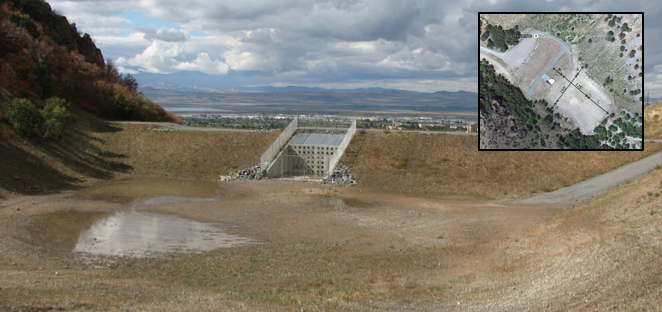David Tarboton, PhD, PE
Professor, Utah State University. Contact: david.tarboton@usu.edu
Madeline Merck
Graduate Research Assistant. Contact: madeline.merck@aggiemail.usu.edu

Flash flooding is a hazard in many parts of the world. In the Rocky Mountains, flash flooding is common in mountain canyons, desert washes, and other such topographic areas featuring mountainous terrain where runoff from rainfall quickly accumulates in gullies or ravines. A flash flood is a sudden and rapid rise in stream water depth resulting from heavy, localized rainfall. With a growing population, developing neighborhoods in terrain susceptible to flash floods has become more common and therefore increased the potential for damage to private property and public infrastructure.
Hydrologists are frequently required to design flood protection infrastructure to protect people and property from the impacts of flash flooding. This module is based on a case study of a flood protection project at the mouth of Dry Canyon located near Logan, Utah. An important hydrologic question in designing for flood protection is: How much flow occurs in a river in response to a given amount of rainfall? To answer this question, we need to know where water goes when it rains, how long does water reside in a watershed, and what pathway does water take to the stream channel. This module helps students learn about the hydrologic processes and analyses needed to address these questions.
In this module you will use the engineering design process to design a detention basin for use in protecting an area of urban development from flooding. In doing so, you will learn about specific topics in hydrology. The sections of the module are organized in conjunction with the steps of a typical design process, including data gathering and analysis, design using hand calculations and computer software (HEC-HMS).
Watershed Properties
Precipitation Analysis
Runoff and Infiltration
Inflow and Outflow Hydrographs
Reservoir Design
Modeling with HEC-HMS
Students should understand the basic physics of water movement from prior classes in Hydraulics and Physics as well as have an ability to work with and analyze data using software such as Excel.
At the end of this case study, a student should be able to describe and implement the steps involved in:
delineating a watershed
acquiring and analyzing precipitation and soils data
developing a design storm hyetograph
developing a runoff hydrograph
designing a detention basin to provide flood protection
Professor, Utah State University. Contact: david.tarboton@usu.edu
Graduate Research Assistant. Contact: madeline.merck@aggiemail.usu.edu
Completed results templates for each learning activity are available and can be requested by instructors from the course developers by emailing Emad Habib.
Junior/Senior Hydrology and Water Resources Engineering Courses
Computer with access to Internet, Excel, and free HEC-HMS software
A student could expect to complete this module with approximately 15 work hours.
This course is available for export by clicking the "Export Link" at the top right of this page. You will need a HydroLearn instructor studio account to do this. You will first need to sign up for a hydrolearn.org account, then from your edX Dashboard request the ability to create courses.
Tarboton, D.G., Merck, M.F., (2019), Flash Flood Protection: Logan Dry Canyon, UT. HydroLearn. https://edx.hydrolearn.org/courses/course-v1:HydroLearn+HydroLearn401+2019_S2/about.
Merck, M. F., M. A. Gallagher, E. Habib and D. Tarboton, (2021), "Engineering Students’ Perceptions of Mathematical Modeling in a Learning Module Centered on a Hydrologic Design Case Study," International Journal of Research in Undergraduate Mathematics Education, http://doi.org/10.1007/s40753-020-00131-8
Engineering students need to spend time engaging in mathematical modeling tasks to reinforce their learning of mathematics through its application to authentic problems and real world design situations. Technological tools and resources can support this kind of learning engagement. We produced an online module that develops students’ mathematical modeling skills while developing knowledge of the fundamentals of rainfall-runoff processes and engineering design. This study examined how 251 students at two United States universities perceived mathematical modeling as implemented through the online module over a 5-year period. We found, subject to the limitation that these are perceptions from not all students, that: (a) the module allowed students to be a part of the modeling process; (b) using technology, such as modeling software and online databases, in the module helped students to understand what they were doing in mathematical modeling; (c) using the technology in the module helped students to develop their skill set; and (d) difficulties with the technology and/or the modeling decisions they had to make in the module activities were in some cases barriers that interfered with students’ ability to learn. We advocate for instructors to create modules that: (a) are situated within a real-world context, requiring students to model mathematically to solve an authentic problem; (b) take advantage of digital tools used by engineers to support students’ development of the mathematical and engineering skills needed in the workforce; and (c) use student feedback to guide module revisions.